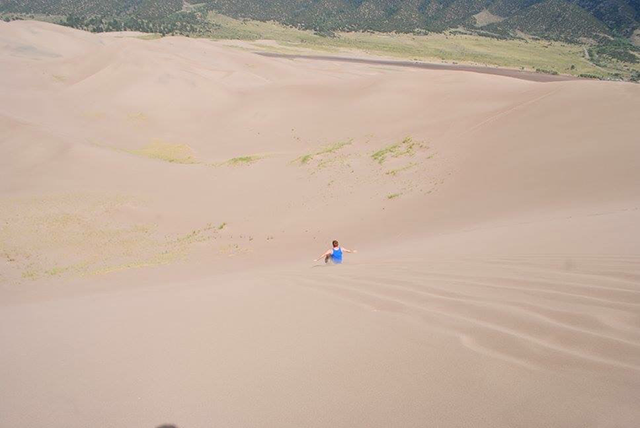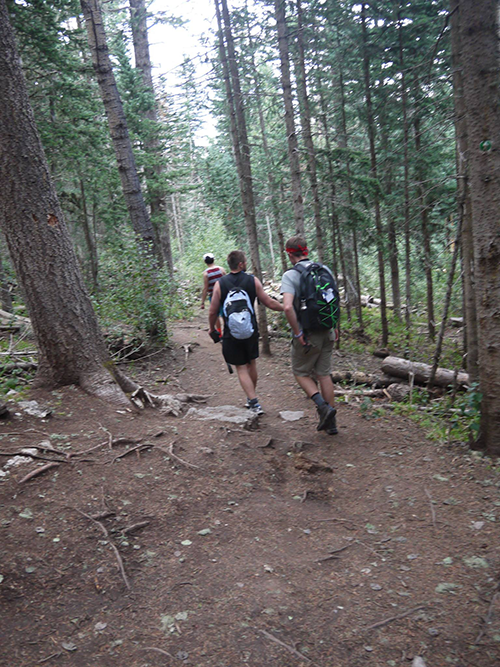Just when you’re about to lose attention from your project in the utter significance of the atomic city – Los Alamos, NM – or the stunning beauty of the tent rock canyon, the excitement of working with top researchers in the field of materials physics reels you back. As my summer at Los Alamos National Laboratory (LANL) comes to an all too fast close, I cannot help but reflect on not only how much my project has grown, but also my ability as a researcher. Asking better questions, becoming independent in my work and thinking, and learning how to seek the right people with the right expertise are just a few of the ways this summer has allowed me to grow.

Having fun sledding down the dunes during a trip to Great Sand Dunes National Park.
My research looks to answer the questions surrounding the kinetics of self-organizing nanostructures with long range periodicities. This fundamental materials science research is important for the use of physical vapor deposition in advanced technologies, such as metamaterials, which require nanoscale features and long range periodicities that are unachievable with current nanolithography techniques without large cost. In order to be able to control the length scale of these phase-separated structures in metallic thin films, a systematic experimental study that extracts the influence of deposition parameters on film morphology is essential. Thus, learning these sputtering techniques at LANL from Kevin was important so I can take these skills back with me to the University of Michigan.
Working with materials with nanoscale structure requires very specialized equipment and expertise. This equipment is currently not available to our research group at the University of Michigan, so a trip to LANL was required. A multitude of trainings, guards with large weapons, and having to wear an ID badge all made being introduced to the national lab setting certainly interesting.
Once the logistical requirements were met, I couldn’t wait to stick my arms elbow-deep into the physical vapor deposition chamber to prepare some self-organizing metallic thin films. The technician, Kevin, was very patient with me as he taught me the initially-complex order of the process, including loading the sample, writing the recipe, and unloading the samples. He even worked closely with me to develop a quench stage that he had little experience with, but loved the idea of the challenge.
Now that we have some samples prepared, the next step is to use electron microscopy to characterize the structure of the deposited films to fully understand how deposition conditions affect the structure of the material. For this, I was taken under Nate Mara’s wing. Dr. Mara’s expertise in electron microscopy and material properties has been central in learning how to probe the microstructure of these films. Even though we have these microscopes back in Michigan, just hearing the differences in Nate’s style provided for fruitful discussions. Information I will surely be taking back to Michigan when I complete the characterization of the films I deposited here.
While my time here at LANL has certainly encountered snags, because of equipment failure and construction on campus, the chance to discuss my project with researchers with varied backgrounds has given me much to ponder and certainly challenged my previous understanding of the research question at hand.
One such experience was presenting my work to a theorist who asked tough questions about the underlying fundamental physics. Before this, I had been thinking of the problem more in a macroscopic scale and in some ways shooting in the dark for possible explanations as to why the structure of our materials looked the way it did. This theorist – Dr. Hoagland – challenged me to first think about the problem in a simple, yet logical way. He asked me to consider what was happening at each time step during our synthesis process, instead of considering the whole sample at once. He remarked that the best researchers are those that act like the toddler who constantly asked why. Furthermore, being able to explain complex ideas to a toddler and researcher alike is a key skill going forward. I am very pleased to have made this connection with Dr. Hoagland and will surely be asking for his advice and expertise in the future.
Experiences like this have led me to start thinking about my research questions at a deeper level than before. Whether it’s looking at an article or newly collected data, the questions of why and how (and many iterations of this line of questioning afterwards) are vitally important to finally answering the scientific issues at hand. This new way of looking at information in front of me will now become a permanent tool in my research toolbox.
Add all of these experiences to the chance to go hiking in the beautiful scenery that is New Mexico and the southwest has made this experience all the more worthwhile. Mix this with befriending students from places all over the world like France and Vietnam and you get a pretty cool summer. These friends worked in the laboratory alongside me and allowed me to have fun even as the work became challenging at points. I have the Rackham Graduate Student Travel Grant to thank for this amazing summer filled with growth and learning.

Hiking with friends on the La Luz trail after reaching the Sandia Peak.
Without this support, my project would certainly suffer from not allowing me to see how my material is deposited first hand, and learning how to create the material on my own. While research is becoming more collaborative, being able to gain some level of independency in research is important for all those involved. Throughout the summer, I realized that it takes a certain degree of careful planning and preparation before jumping in on my own. This is something I did not appreciate before and now understand how this can separate a good researcher from a great one. A part of growing independent in research is realizing that what you do is counted on not only by you, but your advisor, and your colleagues. For this and so much more, I am humbly grateful for being selected for the travel grant.
